warning Citroen NEMO DAG 2010.5 1.G Service Manual
[x] Cancel search | Manufacturer: CITROEN, Model Year: 2010.5, Model line: NEMO DAG, Model: Citroen NEMO DAG 2010.5 1.GPages: 166, PDF Size: 4.11 MB
Page 130 of 166

116
Equipment
ROOF RACK AND ROOF BARS
To install the transverse roof bars or a
roof rack, use the fixings provided for this
purpose.
Maximum load: 75 kg.
OTHER ACCESSORIES
A wide range of accessories and original
parts is offered by the CITROËN network.
These accessories and parts have been
tested and approved both for reliability and
for safety.
They all benefit from CITROËN's
recommendation and warranty.
Never exceed the gross vehicle weight
(GVW). Range of professional equipment
The replacement parts department publishes
an accessories catalogue offering various
equipment and fittings, such as:
- wooden protective floor, non-slip wooden
floors, wooden side protectors, glass
protection grilles,
- roof rack, set of transverse roof bars, loading roller,
- towbars, towbar harnesses with 7/13 sockets, 7/7 sockets, 13 socket... The fitting of electrical equipment or
accessories not listed by CITROËN
may result in the failure of your vehicle's
electronic system or high consumption.
Please note this specific warning. You
are advised to contact a representative
of CITROËN to be shown the range of
recommended equipment and accessories.
Depending on the country in which the
vehicle is sold or operated, it is compulsory
to have a high visibility vest, warning
triangle, replacement bulbs and fuses
available in the vehicle.
You are advised to contact a
representative of CITROËN before
installing accessory radiocommunication
transmitters with external aerial on
your vehicle. Your CITROËN dealer will
inform you of the specification (frequency
band, maximum output power, aerial
position, specific installation conditions)
of the transmitters which can be fitted,
in accordance with the Motor Vehicle
Electromagnetic Compatibility Directive
(2004/104/EC).
When fitting a towbar and harness
outside the CITROËN dealer
network, the installation must be done
using the electrical pre-equipment on the
vehicle and following the manufacture's
recommendations.
Page 131 of 166
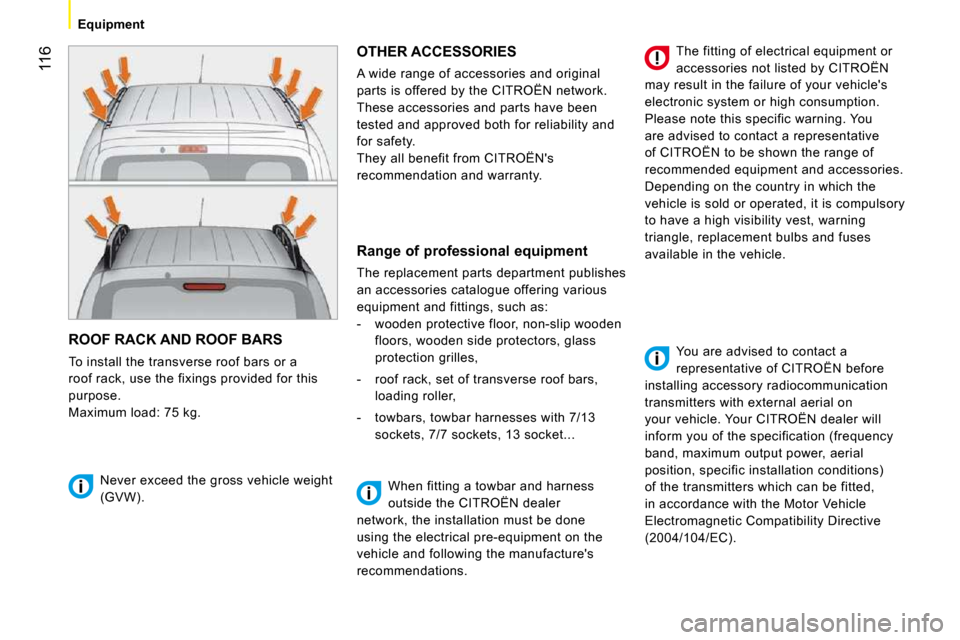
116
Equipment
ROOF RACK AND ROOF BARS
To install the transverse roof bars or a
roof rack, use the fixings provided for this
purpose.
Maximum load: 75 kg.
OTHER ACCESSORIES
A wide range of accessories and original
parts is offered by the CITROËN network.
These accessories and parts have been
tested and approved both for reliability and
for safety.
They all benefit from CITROËN's
recommendation and warranty.
Never exceed the gross vehicle weight
(GVW). Range of professional equipment
The replacement parts department publishes
an accessories catalogue offering various
equipment and fittings, such as:
- wooden protective floor, non-slip wooden
floors, wooden side protectors, glass
protection grilles,
- roof rack, set of transverse roof bars, loading roller,
- towbars, towbar harnesses with 7/13 sockets, 7/7 sockets, 13 socket... The fitting of electrical equipment or
accessories not listed by CITROËN
may result in the failure of your vehicle's
electronic system or high consumption.
Please note this specific warning. You
are advised to contact a representative
of CITROËN to be shown the range of
recommended equipment and accessories.
Depending on the country in which the
vehicle is sold or operated, it is compulsory
to have a high visibility vest, warning
triangle, replacement bulbs and fuses
available in the vehicle.
You are advised to contact a
representative of CITROËN before
installing accessory radiocommunication
transmitters with external aerial on
your vehicle. Your CITROËN dealer will
inform you of the specification (frequency
band, maximum output power, aerial
position, specific installation conditions)
of the transmitters which can be fitted,
in accordance with the Motor Vehicle
Electromagnetic Compatibility Directive
(2004/104/EC).
When fitting a towbar and harness
outside the CITROËN dealer
network, the installation must be done
using the electrical pre-equipment on the
vehicle and following the manufacture's
recommendations.
Page 132 of 166

117
6
ACCESSORIES
Equipment
Range of accessories for private vehicles
Another range is also available from
CITROËN dealers.
"Comfort":
insulated module, coat hanger fixed to a
head restraint, reading lamp, rear parking
sensors...
"Transport solutions":
boot liner, rear door net, set of transverse
and longitudinal roof bars, roof boxes...
"Style":
embellishers... "Security and safety":
anti-intrusion alarm, window etching,
breathalyzer, first aid kit, high visibility vest,
warning triangle, child seats and booster
cushions, snow chains...
"Protection":
rubber mats, over-carpets, 3D mats, seat
covers compatible with lateral airbags...
"Multimedia":
audio systems, hands-free kit, speakers,
portable satellite navigation systems, speed
camera detectors...
By going to a CITROËN dealer, you can also
obtain cleaning and maintenance products
(interior and exterior) - including ecological
products from the "TECHNATURE" range -
products for topping up (screenwash...), touch-
up pens and paint aerosols for the exact colour
of your vehicle, recharges (cartridge for the
temporary puncture repair kit...), ...
To avoid any risk of jamming of the pedals:
- ensure that the mat is positioned and
secured correctly,
- never fit one mat on top of another.
Page 155 of 166
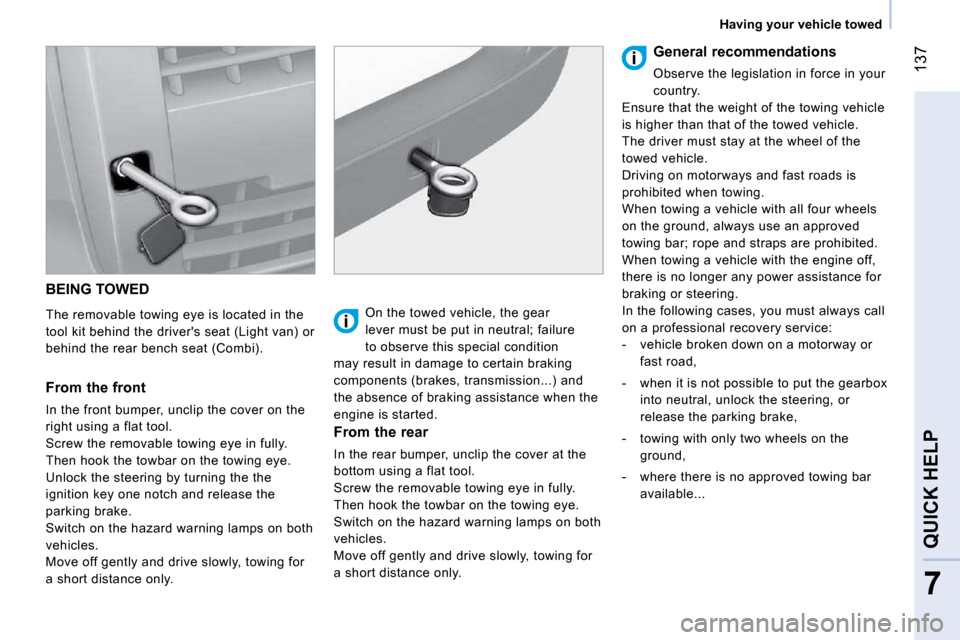
137
7
QUICK HELP
Having your vehicle towed
BEING TOWED
The removable towing eye is located in the
tool kit behind the driver's seat (Light van) or
behind the rear bench seat (Combi).
From the front
In the front bumper, unclip the cover on the
right using a flat tool.
Screw the removable towing eye in fully.
Then hook the towbar on the towing eye.
Unlock the steering by turning the the
ignition key one notch and release the
parking brake.
Switch on the hazard warning lamps on both
vehicles.
Move off gently and drive slowly, towing for
a short distance only. On the towed vehicle, the gear
lever must be put in neutral; failure
to observe this special condition
may result in damage to certain braking
components (brakes, transmission...) and
the absence of braking assistance when the
engine is started.
From the rear
In the rear bumper, unclip the cover at the
bottom using a flat tool.
Screw the removable towing eye in fully.
Then hook the towbar on the towing eye.
Switch on the hazard warning lamps on both
vehicles.
Move off gently and drive slowly, towing for
a short distance only. General recommendations
Observe the legislation in force in your
country.
Ensure that the weight of the towing vehicle
is higher than that of the towed vehicle.
The driver must stay at the wheel of the
towed vehicle.
Driving on motorways and fast roads is
prohibited when towing.
When towing a vehicle with all four wheels
on the ground, always use an approved
towing bar; rope and straps are prohibited.
When towing a vehicle with the engine off,
there is no longer any power assistance for
braking or steering.
In the following cases, you must always call
on a professional recovery service:
- vehicle broken down on a motorway or fast road,
- when it is not possible to put the gearbox into neutral, unlock the steering, or
release the parking brake,
- towing with only two wheels on the ground,
- where there is no approved towing bar available...
Page 157 of 166
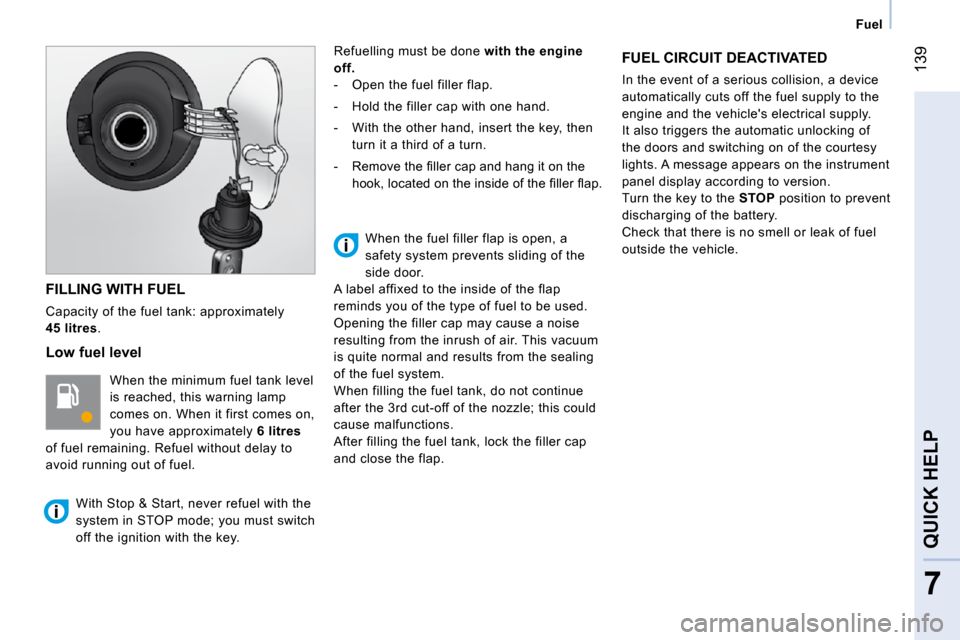
139
7
QUICK HELP
Fuel
FILLING WITH FUEL
Capacity of the fuel tank: approximately
45 litres .
Low fuel level
When the minimum fuel tank level
is reached, this warning lamp
comes on. When it first comes on,
you have approximately 6
litres
of fuel remaining. Refuel without delay to
avoid running out of fuel. Refuelling must be done
with the engine
off.
- Open the fuel filler flap.
- Hold the filler cap with one hand.
- With the other hand, insert the key, then turn it a third of a turn.
� � �-� � �R�e�m�o�v�e� �t�h�e� �fi� �l�l�e�r� �c�a�p� �a�n�d� �h�a�n�g� �i�t� �o�n� �t�h�e� �h�o�o�k�,� �l�o�c�a�t�e�d� �o�n� �t�h�e� �i�n�s�i�d�e� �o�f� �t�h�e� �fi� �l�l�e�r� �fl� �a�p�.� �
FUEL CIRCUIT DEACTIVATED
In the event of a serious collision, a device
automatically cuts off the fuel supply to the
engine and the vehicle's electrical supply.
It also triggers the automatic unlocking of
the doors and switching on of the courtesy
lights. A message appears on the instrument
panel display according to version.
Turn the key to the STOP position to prevent
discharging of the battery.
Check that there is no smell or leak of fuel
outside the vehicle.
With Stop & Start, never refuel with the
system in STOP mode; you must switch
off the ignition with the key. When the fuel filler flap is open, a
safety system prevents sliding of the
side door.
A label affixed to the inside of the flap
reminds you of the type of fuel to be used.
Opening the filler cap may cause a noise
resulting from the inrush of air. This vacuum
is quite normal and results from the sealing
of the fuel system.
When filling the fuel tank, do not continue
after the 3rd cut-off of the nozzle; this could
cause malfunctions.
After filling the fuel tank, lock the filler cap
and close the flap.
Page 158 of 166
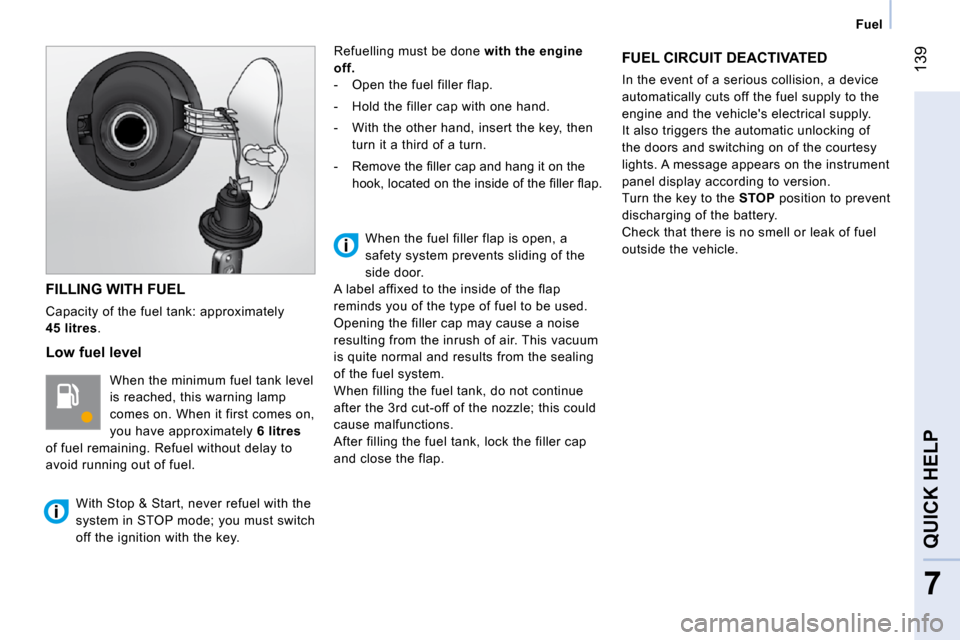
139
7
QUICK HELP
Fuel
FILLING WITH FUEL
Capacity of the fuel tank: approximately
45 litres .
Low fuel level
When the minimum fuel tank level
is reached, this warning lamp
comes on. When it first comes on,
you have approximately 6
litres
of fuel remaining. Refuel without delay to
avoid running out of fuel. Refuelling must be done
with the engine
off.
- Open the fuel filler flap.
- Hold the filler cap with one hand.
- With the other hand, insert the key, then turn it a third of a turn.
� � �-� � �R�e�m�o�v�e� �t�h�e� �fi� �l�l�e�r� �c�a�p� �a�n�d� �h�a�n�g� �i�t� �o�n� �t�h�e� �h�o�o�k�,� �l�o�c�a�t�e�d� �o�n� �t�h�e� �i�n�s�i�d�e� �o�f� �t�h�e� �fi� �l�l�e�r� �fl� �a�p�.� �
FUEL CIRCUIT DEACTIVATED
In the event of a serious collision, a device
automatically cuts off the fuel supply to the
engine and the vehicle's electrical supply.
It also triggers the automatic unlocking of
the doors and switching on of the courtesy
lights. A message appears on the instrument
panel display according to version.
Turn the key to the STOP position to prevent
discharging of the battery.
Check that there is no smell or leak of fuel
outside the vehicle.
With Stop & Start, never refuel with the
system in STOP mode; you must switch
off the ignition with the key. When the fuel filler flap is open, a
safety system prevents sliding of the
side door.
A label affixed to the inside of the flap
reminds you of the type of fuel to be used.
Opening the filler cap may cause a noise
resulting from the inrush of air. This vacuum
is quite normal and results from the sealing
of the fuel system.
When filling the fuel tank, do not continue
after the 3rd cut-off of the nozzle; this could
cause malfunctions.
After filling the fuel tank, lock the filler cap
and close the flap.
Page 163 of 166
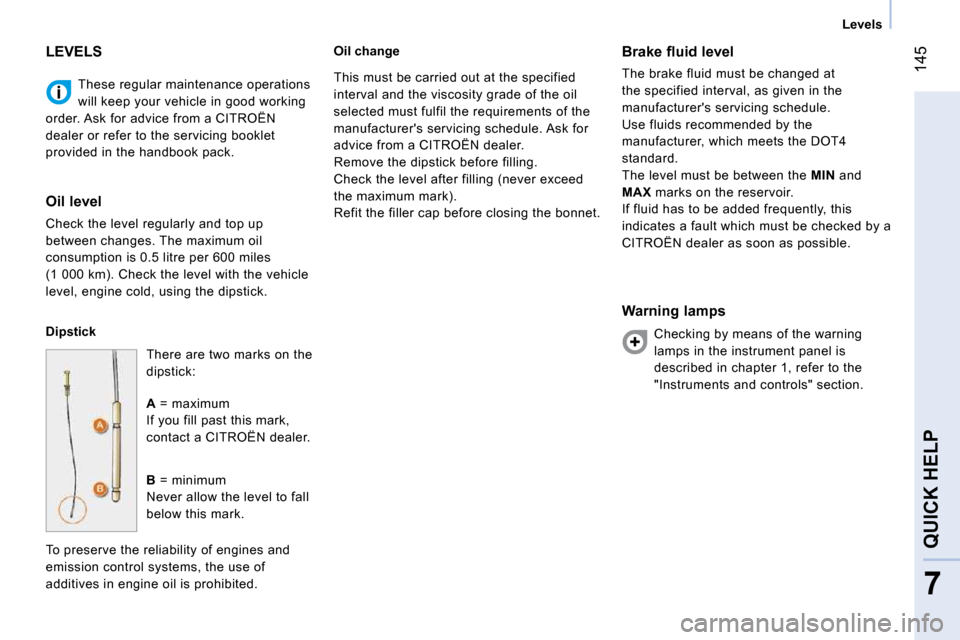
145
7
QUICK HELP
Levels
These regular maintenance operations
will keep your vehicle in good working
order. Ask for advice from a CITROËN
dealer or refer to the servicing booklet
provided in the handbook pack.
LEVELS
Oil level
Check the level regularly and top up
between changes. The maximum oil
consumption is 0.5 litre per 600 miles
(1 000 km). Check the level with the vehicle
level, engine cold, using the dipstick.
Dipstick There are two marks on the
dipstick:
A = maximum
If you fill past this mark,
contact a CITROËN dealer.
B = minimum
Never allow the level to fall
below this mark.
To preserve the reliability of engines and
emission control systems, the use of
additives in engine oil is prohibited. Oil change
Brake fluid level
The brake fluid must be changed at
the specified interval, as given in the
manufacturer's servicing schedule.
Use fluids recommended by the
manufacturer, which meets the DOT4
standard.
The level must be between the MIN and
MAX marks on the reservoir.
If fluid has to be added frequently, this
indicates a fault which must be checked by a
CITROËN dealer as soon as possible.
Warning lamps
Checking by means of the warning
lamps in the instrument panel is
described in chapter 1, refer to the
"Instruments and controls" section.
This must be carried out at the specified
interval and the viscosity grade of the oil
selected must fulfil the requirements of the
manufacturer's servicing schedule. Ask for
advice from a CITROËN dealer.
Remove the dipstick before filling.
Check the level after filling (never exceed
the maximum mark).
Refit the filler cap before closing the bonnet.
Page 165 of 166

147
7
QUICK HELP
Checks
CHECKS
Bleeding water from the Diesel filter If this warning lamp comes
on, you must bleed the filter;
otherwise bleed the filter
regularly, every time the engine is
changed.
To remove the water, unscrew the bleed
screw or the water in Diesel sensor, located
at the base of the filter. Operate until all of
the water has flowed out. Then tighten the
bleed screw or the water sensor.
HDi engines use advanced technology. All
work requires specialist knowledge, which
all CITROËN dealers have. Battery
At the start of winter, have your battery
checked by a CITROËN dealer.
Air filter and passenger compartment filter
A blocked passenger compartment filter
may reduce the performance of the
air conditioning system and generate
undesirable odours. The replacement
intervals for these components are indicated
in the servicing booklet.
Depending on the environment (dusty
atmosphere...) and the use of the vehicle
(urban driving...), change them twice as
often if necessary, refer to the "Under the
bonnet" section of chapter 7. Brake pads
Brake pad wear depends on the style of
driving, in particular for vehicles which are
used in town, over short distances. It may
be necessary to check the brake pad wear,
even between services.
Unless there is a leak on the system, a drop
in the brake fluid level indicates that the
brake pads are worn.
Brake disc/drum wear
For all information on checking the brake
disc/drum wear, contact a CITROËN dealer.
Parking brake
Where the parking brake travel is too great
or there is a reduction in the performance
of the system, the parking brake should be
adjusted, even between services.
Have the system checked by a CITROËN
dealer.
Oil filter
Change the filter regularly, in accordance
with the servicing schedule.
The presence of this label, in particular wi
th
the Stop & Start system, indicates the use
of a specific 12 V lead-acid battery with
special technology and specification, for
which the involvement of a CITROËN dealer
is required when replacing or disconnecting
the battery.
Failure to observe this recommendation may
cause premature wear of the battery.
Page 166 of 166

Checks
Manual gearbox
The gearbox does not require any
maintenance (no oil change).
Refer to the Warranty and Maintenance
Record for the details of the level checking
interval for this component.
To check the main levels and certain
components, in accordance with the
manufacturer's servicing schedule, refer to
the pages of the servicing booklet which
correspond to your vehicle's engine.
Only use products recommended by
CITROËN or products of equivalent quality
and specification.
In order to optimise the operation of units as
important as the braking system, CITROËN
selects and offers specific products.
In order to avoid damaging the electrical
units, high pressure washing to clean the
engine compartment is strictly prohibited. Particle filter system (1.3 HDi 75)
An addition to the catalytic converter, this
�fi� �l�t�e�r� �m�a�k�e�s� �a�n� �a�c�t�i�v�e� �c�o�n�t�r�i�b�u�t�i�o�n� �t�o� �t�h�e�
preservation of air quality by the retaining of
the unburnt pollutant particles. Black exhaust
fumes are thus no longer emitted.
� �T�h�i�s� �fi� �l�t�e�r�,� �fi� �t�t�e�d� �t�o� �t�h�e� �e�x�h�a�u�s�t� �s�y�s�t�e�m�,�
accumulates particles of soot. The engine
control unit manages the automatic
periodic elimination of the soot particles
(regeneration).
the regeneration procedure is invoked
according to the quantity of particles
accumulated and the driving conditions of the
vehicle. During this phase, you may notice
some unusual phenomena - increased idling
speed, cooling fan running, increase in smoke
and higher exhaust gas temperature - which
does not affect the operation of the vehicle or
the environment.
After prolonged idling or driving at very low
speeds, you may occasionally notice water
vapour being emitted from the exhaust when
accelerating. This is of no consequence to the
running of the vehicle or to the environment.
Saturation/Regeneration
If there is risk of blockage of the
filter, this warning lamp comes on
in the instrument panel.
This alert tells you that the particle filter
is starting to fill up (in conditions of urban
driving of exceptionally long duration: low
speeds, traffic jams etc.)
To regenerate the filter, it is advised to drive
as soon as possible, when traffic conditions
and the law permit, at a speed of at least
40 mph (around 60 km/h), with an engine
speed above 2 000 rpm for about fifteen
minutes (until the warning lamp and/or the
message disappears).
if possible, avoid switching off the engine
before the end of regeneration of the
filter; repeated interruptions could cause
premature deterioration of the engine oil. It
is not recommended to end regeneration of
the filter with the vehicle stationary.
Operating fault
If this alert persists, do not ignore the
warning; it indicates that a fault has occurred
in the exhaust/particle filter system.
Have it checked by a CITROËN dealer.
Electronic gearbox
The gearbox does not require any
maintenance (no oil change).
Refer to the servicing booklet for details of
the checking interval for this component.
Because of the higher exhaust
gas temperature resulting from the
�n�o�r�m�a�l� �o�p�e�r�a�t�i�o�n� �o�f� �t�h�e� �p�a�r�t�i�c�l�e� �fi� �l�t�e�r�,� �i�t� �i�s�
recommended that you do not park the vehicle
�o�v�e�r� �i�n�fl� �a�m�m�a�b�l�e� �m�a�t�e�r�i�a�l�s� �(�g�r�a�s�s�,� �d�r�y� �l�e�a�v�e�s�,�
�p�i�n�e� �n�e�e�d�l�e�s�,� �.�.�.�)� �s�o� �a�s� �t�o� �a�v�o�i�d� �a�n�y� �r�i�s�k� �o�f� �fi� �r�e�. �